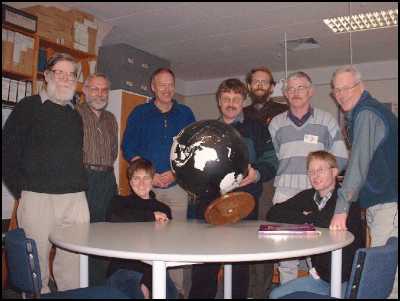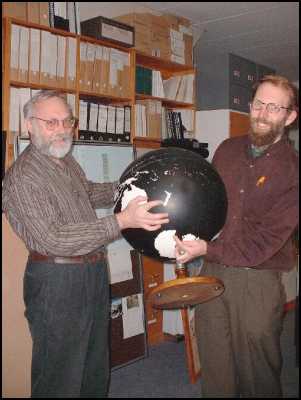Eroding Uncertainty In Greenhouse Gas Emissions
Eroding Uncertainty In New Zealand's Greenhouse Gas Emissions

Scientists from a range of organisations and countries unite to address New Zealand's erosion-linked greenhouse gas issues. Among them are: Dr David Giltrap, Dr Aleksey Sidorchuk, Landcare Research; Hannah Brackley, Landcare Research; Dr Rob Davies-Colley, NIWA; Programme leader, Dr Noel Trustrum, Landcare Research; Dr Troy Baisden, Landcare Research; Dr Murray Hicks, NIWA, Dr Nick Preston, Landcare Research; and Science leader Dr Kevin Tate, Landcare Research.
When people think of greenhouse gas emissions, they generally think of air pollution from burning fossil fuels and, in New Zealand's case, methane emitted by cows and sheep. Few suspect that our national carbon stocks and net greenhouse gas emissions may also be significantly affected by soil or the loss of it through erosion. Landcare Research is leading a project to produce a national erosion-related carbon budget, to show how much carbon is lost from eroded soil, and released from soil into the atmosphere.
Soil acts as a sink for atmospheric carbon dioxide (CO2), trapping and storing large quantities of carbon from plant photosynthesis as forest litter and soil organic matter. When hillslope soils erode, this soil carbon is lost in sediment that is washed into rivers and deposited on to floodplains, or carried out to sea. New Zealand has a relatively high rate of carbon loss from erosion compared to many Western countries. Loss of soil reduces the nation's ability to absorb rising levels of atmospheric CO2.
Landcare Research scientists, along with Drs Murray Hicks and Rob Davies-Colley from NIWA and private consultant Dr David Giltrap, have gathered to set their course for a two-year project to find out the details of these erosion-linked carbon losses. The project has an international flavour, with four new staff joining Landcare Research from the United States, Germany and Russia, to share their skills and experience from the Northern Hemisphere. These people, and PhD student Hannah Brackley, will combine their expertise on soil, riverine, and marine processes to chart what happens to carbon as soil is transported from land to the sea.
Understanding the processes that convert soil carbon into atmospheric CO2 and finding out just how much carbon is released from the soil into the atmosphere is an important aspect of the research, both globally and nationally. "The current New Zealand data related to carbon losses from erosion is very patchy" says programme leader, Dr Noel Trustrum of Landcare Research. "Not only do we need to know how much carbon goes into the atmosphere, but how much is associated with stripped soil, so we can estimate New Zealand's ability to recover from the effects of global warming".
"Soil loss through erosion begins an insidious cycle" says Dr Trustrum. "Because erosion has removed much of the soil, vegetation takes longer to grow. Therefore, not as much carbon dioxide is taken out of the atmosphere and not as much carbon is sequestered back into the soil".
"We have already produced a preliminary carbon budget for the Waipaoa Basin north of Gisborne. This area has gained attention from scientists around the world because of its very high erosion rate. From this we completed New Zealand's first national scale estimate of the potential loss of carbon by soil erosion. Although these preliminary estimates have a very large uncertainty, they suggest losses that might almost equal the carbon sequestered annually by New Zealand's plantation forests".
"We now intend to reduce this uncertainty by at least 50 percent, and to develop a predictive understanding of the impacts of changing land use and climate variability on carbon transfer, both for individual catchments, and for the whole country".
"Areas that are likely to contribute the most to carbon losses, especially areas where there have been human-induced land use changes such as agricultural and forestry practices, will certainly include the east coasts of the North and South Islands, and parts of Northland" says Dr Trustrum.
Dr Trustrum says the project is likely to reveal some surprising facts about erosion - carbon links. "For example, in the Waipaoa basin, sheet erosion (where the topsoil is washed away by rainwater) accounts for only about 10 percent of the soil eroded. But it can account for about 40 percent of the carbon that is lost. On the other hand, more than half the soil, but less than 20 percent of the carbon, is lost through landslides and deep gullies".

East meets West: Dr Aleksey Sidorchuk from Moscow State University and Dr Troy Baisden from the University of Southern California have both joined Landcare Research, and are now joining forces to tackle New Zealand's erosion and carbon loss issues.
Landcare Research science leader Dr Kevin Tate says the emphasis of the research is to find ways to mitigate CO2 emissions. "The gradual warming of the earth's temperature is, and will remain, an internationally recognised problem" he says. "Under the terms of the Kyoto protocol, soil can be recognised as an atmospheric carbon sink, but only if the carbon recovery is human-induced, and verifiable through scientific evidence. Therefore, carbon sinks may become a marketable commodity if countries are permitted to use them to meet their international obligations".
"Whatever the future of the Kyoto Protocol the United States has recently rejected it New Zealand and many other countries will continue in attempts to mitigate their greenhouse gas outputs".
ENDS


 University of Auckland: Protecting Young Minds With AI
University of Auckland: Protecting Young Minds With AI Greenpeace: Greenpeace Calls On Fonterra Investors To Consider Big Picture With Giant Puzzle
Greenpeace: Greenpeace Calls On Fonterra Investors To Consider Big Picture With Giant Puzzle Hugh Grant: How New Tech Helps Kids Love Soccer More
Hugh Grant: How New Tech Helps Kids Love Soccer More Bill Bennett: Download Weekly - 100% claim lands One New Zealand in criminal court action
Bill Bennett: Download Weekly - 100% claim lands One New Zealand in criminal court action FSCL: Woman Scammed Out Of $25,000 After Job Offer On LinkedIn
FSCL: Woman Scammed Out Of $25,000 After Job Offer On LinkedIn NIWA: Cheers To Crustaceans - New Species Named After Welly Brewery
NIWA: Cheers To Crustaceans - New Species Named After Welly Brewery



